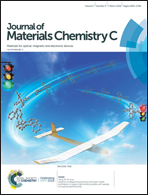Prospects for experimental realization of two-dimensional aluminium allotropes†
Abstract
Following the example of graphene, recent studies discovered a number of atomically thin monoelemental materials. Many of them were synthesized, while some of them still await their experimental realization. Motivated by the huge application potential, inherited from its bulk counterpart, the present study concerns the conditions under which the aluminium monolayer, aluminene, could be synthesized in the laboratory for the first time. We start by considering four different allotropic modifications: planar, buckled, triangular and puckered. The study shows that planar and triangular allotropes can be stabilized by strain engineering imposed upon the monolayer. Ab initio simulations show that these allotropes have appropriate cohesive energies and stable lattice dynamics. We discover that Cu(111) and graphene can act as suitable substrates for the synthesis of aluminene. Substrate–monolayer interaction causes the necessary in-plane strain to stabilize the phonon dynamics. The studied aluminene allotropes are stable with respect to thermal effects at room temperature. STM images are simulated to facilitate future experimental characterization of aluminene. Aluminene preserves the good thermal properties (specific heat) of aluminium, further advancing its application as an ultra-thin thermal insulator or heatsink. The study will stimulate experimental studies focused on both nanomaterial synthesis and applications of atomically-thin aluminium layers. This is key research for future aluminium-based nanoscience.



 Please wait while we load your content...
Please wait while we load your content...